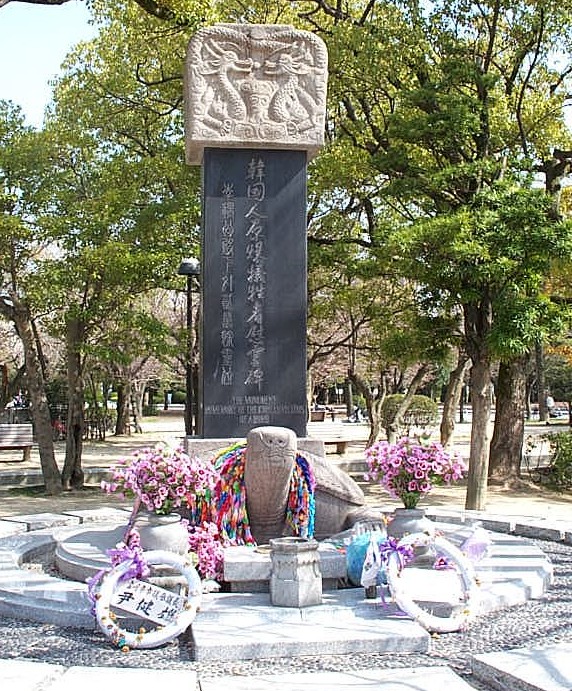The above picture was taken on the evening prior to the 2013 anniversary of the 1945 Nuclear Bombing of the city.The hosts of JapanDesk Scotland were also there making a documentary of what this devastating event meant for the victims of the time and also the current youth of the City that literally rose from the ashes.The Dome featured has become an iconic landmark for the aftermath of the destruction , built by a Czech architect as a symbol of the City fathers desire to become more modern and cosmopolitan by creating modern buildings based on European designs."The main building exhibits victims' belongings and references which show
the misery of the bomb attack. You will see a burnt lunch box, a
tricycle which a 3-year-old boy was riding, etc., which reflect the
instantaneous destruction and strike right at the heart of visitors. The
Hiroshima Peace Memorial Museum
was designed by a group headed by Kenzo Tange, who also designed the
Hiroshima Peace Memorial Park. The strength of humanity rising up from
the ruins is expressed in the piloti-style space under the main
building. People visit the museum throughout the year and should be
moved to a desire not to repeat the same misery anymore and consider
deeply whether atomic weapons currently present are really necessary or
not for our future."
The memorial is inscribed "Let All Souls Here Rest In Peace , For We Shall Not Repeat The Evil" , this has had many political considerations over the years as to who is referred in the "We" , is it the US dropping on the Nuclear Bomb on the ultimate civilian target, Imperial Japanese Policies or Humanity throughout the generations itself.
One of the longer lasting evils was citizens in Hiroshima at the time had to pretend throughout the decades they were not from the city for fear of being unable to marry or be treated as incubators of diseases , real or imagined.The model for the official monument built later was 2 years old at the time of the bombing , 10 years later she was diagnosed with leukemia.The 20,000 Korean victims did not even have recognition for their losses until 1970 , with their commemorative monument being built away from the official one many years later from private subscriptions from Korean descendants.
Sadako Sasaki , a symbol of innocent victims of Hiroshima
Under the US occupation of Japan which lasted until 1952 all discourse about the bombing of Hiroshima and Nagasaki was off limits , especially as the later constitution and military set-up included Japan being part of the US Nuclear security umbrella.With Nuclear Japan being an inescapable fixture the debate among survivors to support efforts to the peaceful uses of Nuclear Power.
As the documentary pointed out Even today many ordinary Hiroshima citizens will not talk about the issue , the subject being taboo on political and social levels.Japanese textbooks cover the events in only a few sentences without the context of the bombings being looked into.
Even in diplomatic circles Ambassadors and diplomatic corps are not taught about the issue and it is considered taboo for older hands to describe the aftermath silence on the issue to younger diplomatic staff to the extent they are not aware of the issues , causes and consequences of the period.Diplomats Old and New complain "Post-war Japan is not allowed its own diplomacy, diplomats have to pretend."
One of the few attempts to discuss the events and aftermath was "Children of Hiroshima," commissioned by the Japan Teachers Union and
based on a compilation of testimonies by a university professor, Arata
Osada, combines documentary naturalism with lyrical and frankly
sentimental passages. The bombing is recalled through a horrific,
surreal montage that anticipates some of the wild imagery Mr. Shindo
would bring to later, horror-inflected movies like "Onibaba" (1964) and
"Kuroneko" (1968). But the overall tone is heartfelt and determined, as
Takako, visiting the small handful of her former kindergarten students
who survived, encounters both unbearable sadness and fragile optimism."
You can see it in the link below:
Because of the education curriculum Japanese Children only study Hiroshima in a detached way , the issue is not even incorporated in the state curriculum with even August 6th being marked in a lowkey abstract way , this means younger Japanese dont feel confident the issue because they do not know much about them.
The video below gives a good overview of the present day remembrance of the awful bombings.
And below is the Korean Memorial to the victims that very few in Japan and the US recognise.
Subscribe to:
Post Comments (Atom)



No comments:
Post a Comment